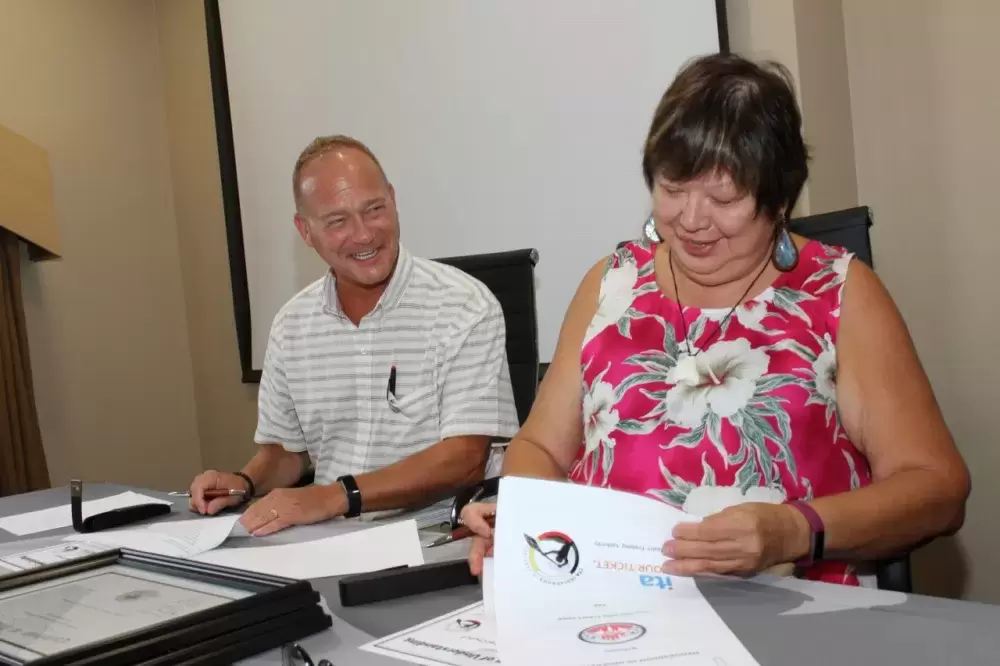The Tla-o-qui-aht First Nation’s number of on-reserve homes has more than doubled over the last decade to 170 – but this has not been enough to keep up with a severe housing shortage.
“We have over 60 to 100 people on our housing application list looking for a home,” said Iris Frank, the First Nation’s education manager. “We have a lot of building to do over the next 10 to 20 years.”
The situation faced by the Tla-o-qui-aht communities of Esowista, Ty-Histanis and Opitsaht is symptomatic of the widespread lack of housing in Nuu-chah-nulth communities. And like other nations, the Tla-o-qui-aht feel the immediate need for skilled people to help serve their growing settlements.
Progress was made last spring, when 19 people from the Tla-o-qhi-aht, Yuułuʔiłʔatḥ and Ahousaht First Nations completed their Level 1 carpentry training. Offered through North Island College, Camosun College and the Nuu-chah-nulth Tribal Council, the eight weeks of training allowed the apprentices to remain in their home communities – including the Ahousaht students who travelled by water taxi each day for the sessions in Ty-Histanis.
Dennis Blackbird’s daughter was born halfway through the program, a family commitment that would have prevented him from attending training in a city far away from his home in Esowista. The new father now works for Tla-o-qui-aht’s operations and maintenance department.
“An opportunity came up,” he said. “I’m willing to keep going forward with it and help build the community up.”
With the goal of empowering Nuu-chah-nulth members to better serve their growing communities, the NTC signed a memorandum of understanding with the province’s Industry Training Authority in Tofino on Aug. 9. This agreement enables the tribal council to take a more active role with the ITA by making the NTC a sponsor for Nuu-chah-nulth apprentices.
“As the MOU has been supported by the Nuu-chah-nulth Tribal Council Board of Directors, it ensures that the interests we pursue are put forth by our communities and its members,” said NTC President Judith Sayers in a media release. “We look forward to building our relationship with ITA to support educational and skills training that focus on Nuu-chah-nulth peoples within our communities.”
More trades training is planned for the fall, including introductory sessions in Tsaxana near Gold River and Kyuquot, where the Ka:'yu:'k't'h'/Che:k'tles7et'h' First Nations are developing their Big House project.
The MOU states its intent to bring “success in trades education and apprenticeship for First Nations” to advance “the betterment, prosperity and well-being of the Nuu-chah-nulth peoples.” The agreement’s focus on providing training in coastal locations means that the education will cater to the specific needs of a community, said Ian Caplette, the NTC’s director of education.
“If we can provide these training programs in community, what happens is the program itself changes and it becomes more adaptable to the realities of the community, which don’t exist in a classroom or a worksite in Nanaimo or Vancouver,” he said.
The Tla-o-qui-aht hopes to be less dependent on hiring contractors than when the Ty-Histanis subdivision was built a decade ago.
“Our goal is to create within our public works department, qualified certified carpenters, pipe fitters - hopefully we’ll get an electrician,” said Frank. “Our goal is also to have a construction company within our nation to be able to take advantage of the opportunities.”
She noted that finding qualified early childhood educators to work in the First Nation’s new daycare proved to be more challenging that building the facility. The centre is still advertising for casual positions.
“We’re fully licenced for up to 52 seats for the daycare, but there was nobody out there,” she said, adding that sending members away for training brings the risk that they’ll remain in a city. “Once you get out to the city you realise how accessible everything is…you have a lot more options.”
As Tla-o-qui-aht’s public works manager, Shawn Quick completed the carpentry training in the spring to upgrade his skills and become more familiar with building codes. Back in 2001 he left his home community when the opportunity arose to study fish and wildlife in Merrit. Those two years of study brought challenges that Quick was able to avoid during the recent training in Ty-Histanis.
“When I went to Merritt, it was difficult. I actually had to get two jobs,” he recalled. “I didn’t get as much time to study, grades weren’t as good as they could have been, [and] I didn’t learn as much as I could have learned.”
Now the public works manager is leading a team of newly trained staff to support life in the Tla-o-qui-aht reserves. One of their ongoing projects is to renovate elders’ homes, including removing mould.
“A lot of our elders, as they aged, they did it with jobs that didn’t provide retirement packages,” said Quick, noting that many of the First Nation’s elders had careers in logging, fishing or factory work. “They didn’t have the knowledge or the processes to be able to set themselves up for when they became elders. A lot them are struggling financially and they can’t afford to renovate their homes. They end up living with mould.”







